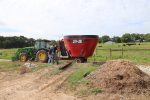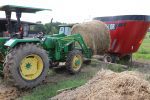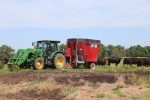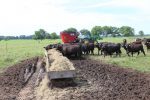In the heart of East Texas, where variable rainfall patterns and droughts are a recurring challenge for cattle ranchers, Randall Bennett, a dedicated veterinarian and owner of Raven Angus, found himself grappling with challenging weather conditions.
With a history of both wet and dry seasons, Texas ranchers have to be well-prepared to handle the fluctuations in forage availability, and the droughts that strike every three to seven years.
As Randall explains, this is highly dependent on the El Niño and La Niña weather phenomena. Last year was a tough one, with only 20 inches of rainfall in six months, leaving him struggling to find enough feed for his 125 pairs of Angus cattle and 35 to 50 bulls and females. To make matters even more challenging, feed
When faced with a dire shortage of feed due to drought conditions, Randall turned to the Jaylor mixer, a recommendation from a fellow client.
Not only did it help with the consistency of the fibre length, ensuring better consumption, but it also played a pivotal role in maintaining the weight and health of his cattle during challenging times.
Randall firmly believes that the key to profitability in the beef cattle business is consumption, and the Jaylor mixer has proven to be a game-changer in this regard. With its ability to create a consistent and high-quality feed mix, he was able to ensure his cattle’s intake was better, even during a short feed year.
The results spoke for themselves, as the weaning weights remained decent, and the Jaylor mixer became an invaluable resource for ranchers navigating the unpredictability of East Texas weather.




Transcription
The drought happens about every three to seven years. It depends on El Nino and El Nina. We see it on a common basis. Like I say today we’re very wet and uh, but last year we were very dry.
My name’s Randall Bennett. I’m a veterinarian in East Texas, little town called Quitman. My operation is Raven Angus, and we are in the registered Angus business, and we raise about 125 pairs, and then about 35 to 50 bulls and females a year.
I’m a veterinarian by trade. I run a five man veterinary practice here in town, and we’re the biggest mixed animal practice in East Texas. My son is my primary help and he helps me in on the operation. Between the two of us, I primarily work as a veterinarian day to day. He’s the one that runs the feed wagon. And so it’s kind of a one man operation. And I think that’s one of the nice things about the mixer wagon. You don’t require a lot of intensive amount of people to do it.
Texas has a history of having variable rainfall. And so we have to make up for it by being prepared to handle the forages that come our way. The drought happens about every three to seven years. It depends on El Nino and El Nina. We see it on a common basis. Uh, this year we’ve had, uh, 40 inches in. In six months, last year we had, uh, 20 inches in the same time period. We’ve had a complete reversal of, of the swings, and that’s why having a system where you can switch up and do some other, other feeding, especially when you don’t have the feedstuffs available.
We’ve been blessed this year with some extra rain. Last year was tough. We were in a drought situation and people were trying to get feed all the way up into the Midwest and into the Dakotas last year because there just wasn’t any feeds available in the South. We only made about 80 bales of hay for that many cows and so we had to buy a bunch of commodities.
Commodity hay we bought was some sorghum hay and some soybean hay. And those became our primary forage source for the year and we upgraded our feeding system with the Jaylor and providing some commodities were less than attractive. And, and upgraded those commodities to a, to a utilizable form. Especially the, the sorghum hay, because it was just sorghum stalks is what it was. And the Jaylor helped us grind it and make it a palatable mix.
Right now we’re using the forages of East Texas. And that’s really important. You can’t haul hay a long ways and make any money in the business. Everybody’s getting shorter margins, tighter margins. So we’re having to change the game so we can compete on a little better basis. We add some water to it to help with the grind. And then we add some silage to our mix to try to help in the palatability and the utilizability of the forage in a better way. Uh, provide a little higher protein content intake, um, and a better final mix with better consumption.
Traditionally this country has been a lot of, a dairy country. And, uh, the old hay and, and grain mix, uh, was getting phased out and people were moving more toward commodity-based feeds. And we’ve had to do the same thing in the beef cattle side, not just the dairy side. Consumption is the key to profitability in the dairy business, and I think it is in the beef business as well. We have some clients that are dairymen and we’ve seen the impact that it has on their dairies also.
We bought the Jaylor because it was recommended from another client of mine, and it provides some flexibility that we didn’t have in our operation. We bought one of the smaller mixers, not the big mixer. We have about a 4,000 pound batch mix that we mix up, and we’ve put about 800 to 1,000 bales through our mixer wagon. It’s done pretty well. We’re at that point right now where we’re moving to another set of knives, and so we’ve had enough experience with it the last year to get a good idea how well it’s going to hold up.
Grind is good. The fiber length is real important. If it’s too, too, uh, long, we really have some consumption issues and the cattle won’t consume it well. If it’s too short, you’ll end up with some, uh, rumenitis and indications of having, uh, off feed type situations. So, you want a real consistent fiber length, fiber mix. The main thing is I think our consumption is better, and so our intake is better and so we’ll have a better chance for gain. Even on a short feed year, um, we were able to survive and, and the calves held their weight, uh, on a normal year that we were as short as we would, we would have lost a considerable amount of weight.
And so, we had a, a decent year, our weaning weights were decent, and, uh, probably would have been 100 pounds lighter if we hadn’t had the Jaylor mixer. I like to say, when you normally make 800 bales and you have 80 bales, you’ve got to have another way to feed them.


